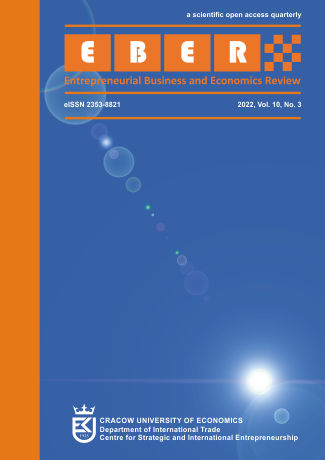Price and output effects of long-term exchange rate changes:
Central and Eastern European countries in 2002-2019
Price and output effects of long-term exchange rate changes:
Central and Eastern European countries in 2002-2019
Author(s): Viktor ShevchukSubject(s): National Economy, Financial Markets, Public Finances
Published by: Uniwersytet Ekonomiczny w Krakowie
Keywords: inflation; exchange rate; money supply; output; Central and Eastern European countries;
Summary/Abstract: Objective: The objective of the article is to measure the magnitude of the long-term exchange rate price and output effects in the Central and Eastern European countries (plus Turkey and Russia) which practice flexible exchange rate policies, while controlling for the institutional quality and policy stance as measured by the Index of Economic Freedom (IEF) from the Heritage Foundation database.Research Design & Methods: To analyse long-term price and output effects, the anticipated value of a nomi- nal effective exchange rate was used as obtained by the ARIMA (n,m) model. We analysed the relationships between selected macroeconomic variables with the panel DOLS model using quarterly data from 2002 to 2019. Individual country estimates were provided as well. The study considered alternative specifications for regression models, with control for the money supply and institutional developments.Findings: Our study revealed that anticipated depreciation of the exchange rate was associated with the incom- plete exchange rate pass-through (ERPT) into consumer prices and a decrease in output, with the former becom- ing stronger over the low-inflationary 2010-2019 period. Among other results, there was a trade-off between price and output effects of the money supply. As expected, investments in physical capital were the factor behind higher output. Finally, liberalisation efforts as proxied with the IEF were inflationary and contractionary. Implications & Recommendations: It was demonstrated that policies aimed at gradual strengthening of local currencies could be helpful for both acceleration of output growth and containment of inflation in the long run. At the same time, it is not recommended to proceed with further liberalisation of regulatory environment, as it seems not to bring about any favourable output effects while contributing to higher consumer prices. Contribution & Value Added: The novelty of this study is the estimation of the long-term price and output effects of the anticipated exchange rate while controlling for institutional quality and the progress of market reforms as measured by the IEF. The findings may serve as suggestions for reliable exchange rate policy, with a focus on predictability and the long-term macroeconomic effects.
Journal: Entrepreneurial Business and Economics Review
- Issue Year: 10/2022
- Issue No: 3
- Page Range: 37-50
- Page Count: 14
- Language: English

